-
 Bitcoin
Bitcoin $107,341.7259
0.15% -
 Ethereum
Ethereum $2,438.6204
0.70% -
 Tether USDt
Tether USDt $1.0003
-0.02% -
 XRP
XRP $2.1866
1.94% -
 BNB
BNB $649.0952
0.36% -
 Solana
Solana $150.9602
5.63% -
 USDC
USDC $0.9999
0.00% -
 TRON
TRON $0.2742
0.40% -
 Dogecoin
Dogecoin $0.1645
1.93% -
 Cardano
Cardano $0.5669
1.18% -
 Hyperliquid
Hyperliquid $37.8286
4.19% -
 Bitcoin Cash
Bitcoin Cash $491.4669
-2.74% -
 Sui
Sui $2.8150
3.06% -
 Chainlink
Chainlink $13.4184
2.91% -
 UNUS SED LEO
UNUS SED LEO $9.0809
0.27% -
 Avalanche
Avalanche $18.0295
2.60% -
 Stellar
Stellar $0.2396
1.19% -
 Toncoin
Toncoin $2.8587
0.13% -
 Shiba Inu
Shiba Inu $0.0...01160
2.59% -
 Litecoin
Litecoin $86.4192
1.45% -
 Hedera
Hedera $0.1486
1.19% -
 Monero
Monero $308.4324
0.87% -
 Polkadot
Polkadot $3.4202
1.43% -
 Bitget Token
Bitget Token $4.6436
-0.34% -
 Dai
Dai $0.9998
-0.02% -
 Ethena USDe
Ethena USDe $1.0002
0.00% -
 Uniswap
Uniswap $7.1527
3.29% -
 Pi
Pi $0.5357
-8.45% -
 Pepe
Pepe $0.0...09588
4.61% -
 Aave
Aave $259.9759
0.81%
What is the difference between USDT and other stablecoins?
USDT, the largest stablecoin, differs from others like USDC and DAI in its collateralization (commercial paper vs. US dollars/Treasuries or crypto), transparency, and regulatory scrutiny, impacting user risk assessment and choice.
Mar 11, 2025 at 04:11 pm
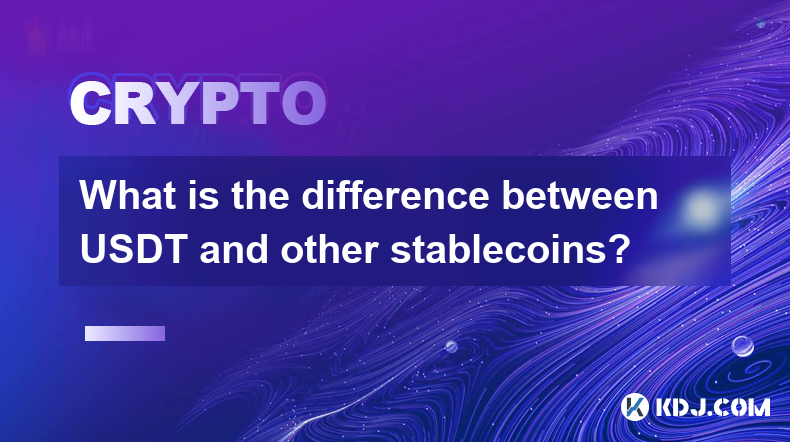
Key Points:
- USDT's market dominance and associated risks.
- Differences in collateralization strategies: USDT (primarily commercial paper), vs. other stablecoins (e.g., USDC, DAI).
- Transparency and audits: variations in the level of public scrutiny and verification.
- Regulatory scrutiny and legal challenges faced by different stablecoins.
- Decentralization vs. Centralization: the spectrum of control and governance models.
- Implications for users: choosing a stablecoin based on risk tolerance and specific needs.
What is the difference between USDT and other stablecoins?
Tether (USDT) and other stablecoins, while sharing the common goal of maintaining a 1:1 peg to the US dollar, differ significantly in their underlying mechanisms, transparency, and regulatory landscape. Understanding these differences is crucial for navigating the complexities of the cryptocurrency market.
USDT, the largest stablecoin by market capitalization, has faced considerable scrutiny regarding its reserves and the transparency of its operations. It's primarily backed by commercial paper, short-term debt issued by corporations. This raises concerns about liquidity and potential counterparty risk, as the value of commercial paper can fluctuate. The lack of complete transparency around the composition of its reserves further fuels skepticism.
In contrast, other stablecoins like USDC employ different collateralization strategies. Circle, the issuer of USDC, typically backs its tokens with a reserve of US dollars and short-term US Treasury securities. This approach is considered by many to be more conservative and less risky than USDT's reliance on commercial paper. However, even USDC's reserves aren't always entirely transparent, leading to ongoing debates about its true level of backing.
Another notable stablecoin, DAI, operates on a decentralized algorithmic model. It's over-collateralized with a mix of cryptocurrencies locked in smart contracts. This decentralized nature aims to mitigate the single point of failure inherent in centralized stablecoins like USDT and USDC. However, the complexity of its algorithm and the potential volatility of its collateral assets introduce a different set of risks.
The level of transparency and independent audits also varies significantly among stablecoins. While some, like USDC, undergo regular audits by reputable accounting firms, others, including USDT, have faced criticism for a lack of comprehensive and frequent audits. This difference in transparency affects investor confidence and the overall perceived risk associated with each stablecoin.
Regulatory scrutiny also plays a significant role. USDT and other stablecoins are facing increasing regulatory pressure globally. The legal challenges and enforcement actions vary depending on jurisdiction and the specific stablecoin. This adds another layer of complexity and uncertainty for users.
The degree of decentralization also differentiates stablecoins. USDT and USDC are centralized, meaning their issuers have control over the supply and management of the tokens. DAI, on the other hand, strives for decentralization through its algorithmic model and community governance. This difference impacts the level of control users have over the stablecoin and its resilience to potential attacks or censorship.
Choosing a stablecoin requires careful consideration of these factors. Users with a higher risk tolerance might be more comfortable with USDT's market dominance, despite the associated risks. Those prioritizing transparency and a more conservative approach might prefer USDC. Users seeking maximum decentralization might opt for DAI, accepting the inherent complexities and potential volatility.
Frequently Asked Questions:
Q: Is USDT safe?
A: The safety of USDT is a subject of ongoing debate. While it maintains its peg to the US dollar, concerns remain about the transparency and risk associated with its commercial paper reserves. Independent audits and regulatory scrutiny are crucial in assessing its overall safety.
Q: What is the difference between USDT and USDC's backing?
A: USDT primarily relies on commercial paper and other short-term debt instruments for backing, while USDC typically utilizes a reserve of US dollars and US Treasury securities. USDC's backing is generally considered more conservative and less risky than USDT's, but both lack complete transparency regarding their reserves.
Q: How does DAI differ from other stablecoins?
A: DAI is an algorithmically-governed, decentralized stablecoin. Unlike USDT and USDC, it's over-collateralized with crypto assets locked in smart contracts, aiming for greater decentralization and resilience to single points of failure. However, this introduces complexities and potential volatility linked to the underlying collateral.
Q: Are all stablecoins regulated equally?
A: No, the regulatory landscape for stablecoins is complex and varies significantly across jurisdictions. Some stablecoins face more intense scrutiny and regulatory pressure than others, depending on their design, issuer, and market presence. This impacts their legal status and potential exposure to regulatory actions.
Q: Which stablecoin is the best?
A: There's no single "best" stablecoin. The optimal choice depends on individual risk tolerance, priorities (decentralization, transparency, etc.), and understanding of the inherent risks associated with each stablecoin's backing and governance model. Thorough research is crucial before making a decision.
Q: What are the risks associated with using stablecoins?
A: Risks associated with stablecoins include: de-pegging from the target currency (e.g., the US dollar), counterparty risk (for centralized stablecoins), algorithmic instability (for algorithmic stablecoins), regulatory uncertainty, and security vulnerabilities within the underlying technology or smart contracts.
Disclaimer:info@kdj.com
The information provided is not trading advice. kdj.com does not assume any responsibility for any investments made based on the information provided in this article. Cryptocurrencies are highly volatile and it is highly recommended that you invest with caution after thorough research!
If you believe that the content used on this website infringes your copyright, please contact us immediately (info@kdj.com) and we will delete it promptly.
- Trump, Bitcoin, and Peter Schiff: A New York Minute on Crypto Chaos
- 2025-06-29 12:30:12
- BTC Price, BlackRock ETF, Fed Signals: Decoding the Crypto Crossroads
- 2025-06-29 12:30:12
- SEI Price Skyrockets Amid ETF Hype and Bullish Uptrend: What's Next?
- 2025-06-29 12:50:11
- Bitcoin Mining, Cryptocurrency, and Blockchain: A New York State of Mind
- 2025-06-29 13:10:11
- Dogecoin's Double Bottom: Is an Explosive Move Imminent?
- 2025-06-29 12:55:11
- Kitten Craze Online: Hunting for the Purr-fect Coin Purse
- 2025-06-29 10:30:12
Related knowledge
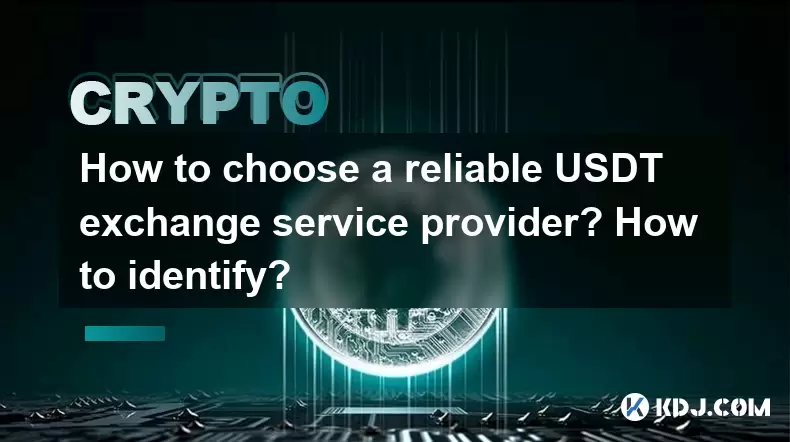
How to choose a reliable USDT exchange service provider? How to identify?
Jun 12,2025 at 03:15pm
Understanding the Role of USDT in Cryptocurrency TradingUSDT (Tether) is one of the most widely used stablecoins in the cryptocurrency market. It is designed to maintain a 1:1 peg with the U.S. dollar, offering traders and investors a way to hedge against volatility while remaining within the crypto ecosystem. Choosing a reliable USDT exchange service p...
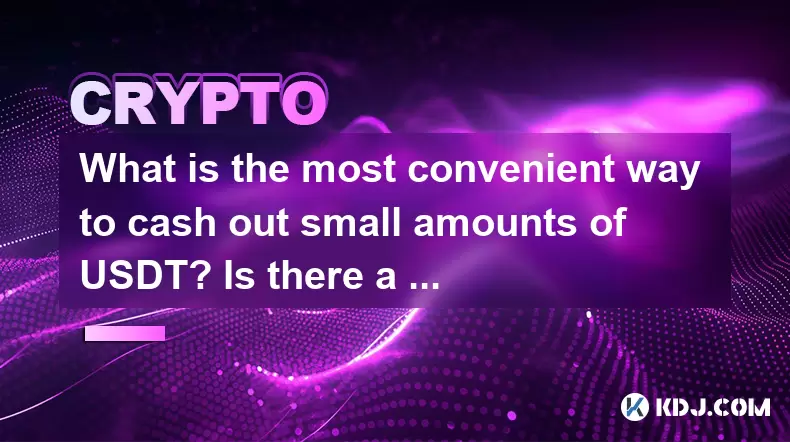
What is the most convenient way to cash out small amounts of USDT? Is there a shortcut?
Jun 11,2025 at 11:00pm
Understanding the Need to Cash Out Small USDT AmountsCashing out small amounts of USDT can be a challenge for many crypto users. Traditional methods often involve high fees, minimum withdrawal limits, or cumbersome verification processes that make it inefficient for small transactions. The key is to find a method that balances speed, cost, and convenien...
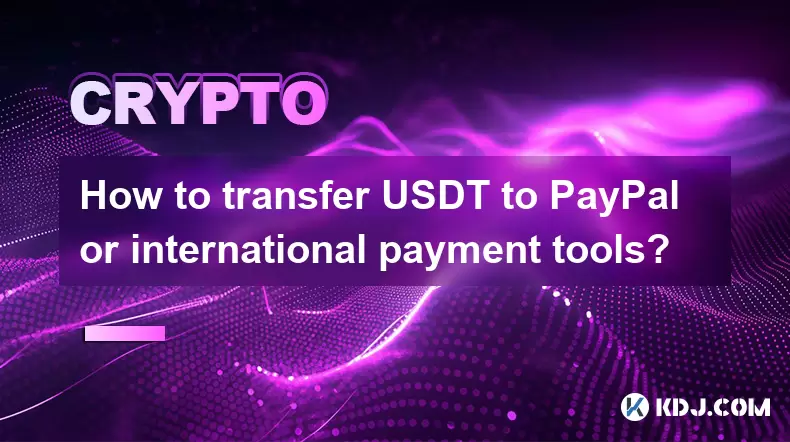
How to transfer USDT to PayPal or international payment tools?
Jun 15,2025 at 05:28am
Understanding the Basics of USDT and PayPal IntegrationUSDT (Tether) is a stablecoin pegged to the US dollar, offering blockchain-based value transfer with minimal volatility. PayPal, on the other hand, is a centralized digital wallet that facilitates fiat currency transactions globally. Direct integration between USDT and PayPal does not exist due to t...
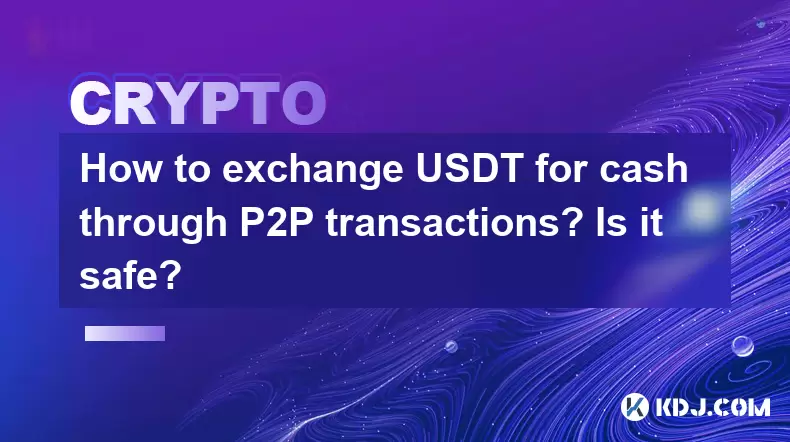
How to exchange USDT for cash through P2P transactions? Is it safe?
Jun 18,2025 at 07:56am
Understanding USDT and P2P TransactionsTether (USDT) is a stablecoin pegged to the value of the US dollar, making it a popular choice for users who want to avoid the volatility of other cryptocurrencies while still participating in the crypto ecosystem. Peer-to-peer (P2P) transactions allow individuals to trade directly with each other without going thr...
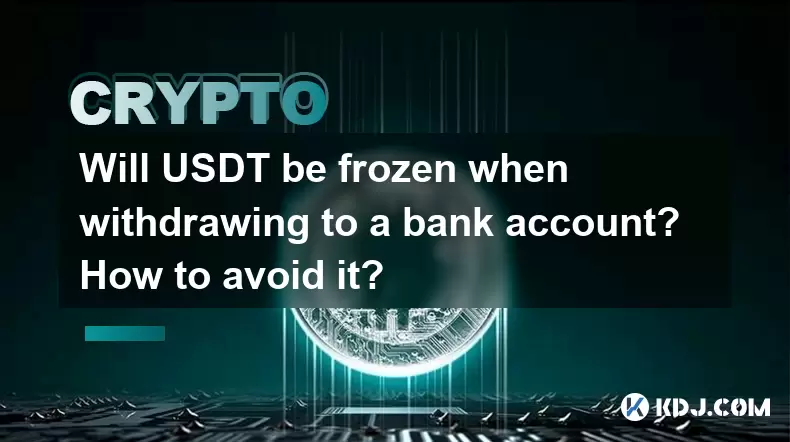
Will USDT be frozen when withdrawing to a bank account? How to avoid it?
Jun 15,2025 at 10:03am
Understanding USDT Withdrawals and Bank Account Freezing RisksWhen users decide to withdraw USDT (Tether) to a bank account, one of the most common concerns is whether their funds will be frozen during the process. This concern stems from real-life cases where individuals have encountered delays or restrictions when converting digital assets into fiat c...
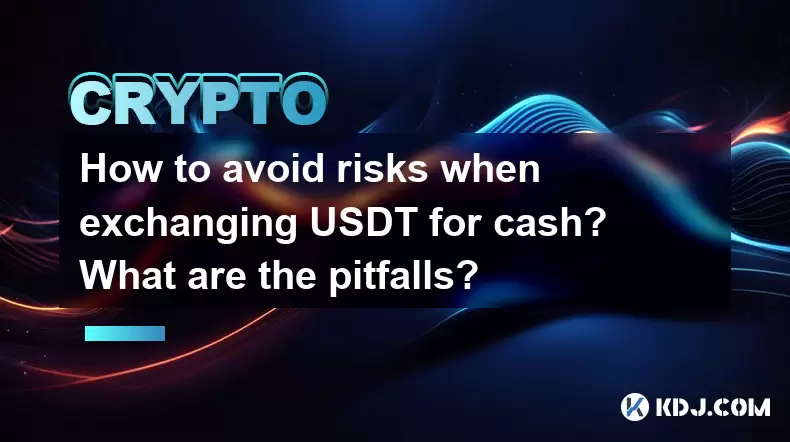
How to avoid risks when exchanging USDT for cash? What are the pitfalls?
Jun 11,2025 at 08:14pm
Understanding the Risks of Exchanging USDT for CashWhen exchanging USDT (Tether) for cash, users must be aware of the potential risks involved. As a stablecoin pegged to the US dollar, USDT is widely used in crypto transactions due to its price stability. However, converting it into fiat currency like USD or CNY can expose users to several pitfalls, inc...

How to choose a reliable USDT exchange service provider? How to identify?
Jun 12,2025 at 03:15pm
Understanding the Role of USDT in Cryptocurrency TradingUSDT (Tether) is one of the most widely used stablecoins in the cryptocurrency market. It is designed to maintain a 1:1 peg with the U.S. dollar, offering traders and investors a way to hedge against volatility while remaining within the crypto ecosystem. Choosing a reliable USDT exchange service p...

What is the most convenient way to cash out small amounts of USDT? Is there a shortcut?
Jun 11,2025 at 11:00pm
Understanding the Need to Cash Out Small USDT AmountsCashing out small amounts of USDT can be a challenge for many crypto users. Traditional methods often involve high fees, minimum withdrawal limits, or cumbersome verification processes that make it inefficient for small transactions. The key is to find a method that balances speed, cost, and convenien...

How to transfer USDT to PayPal or international payment tools?
Jun 15,2025 at 05:28am
Understanding the Basics of USDT and PayPal IntegrationUSDT (Tether) is a stablecoin pegged to the US dollar, offering blockchain-based value transfer with minimal volatility. PayPal, on the other hand, is a centralized digital wallet that facilitates fiat currency transactions globally. Direct integration between USDT and PayPal does not exist due to t...

How to exchange USDT for cash through P2P transactions? Is it safe?
Jun 18,2025 at 07:56am
Understanding USDT and P2P TransactionsTether (USDT) is a stablecoin pegged to the value of the US dollar, making it a popular choice for users who want to avoid the volatility of other cryptocurrencies while still participating in the crypto ecosystem. Peer-to-peer (P2P) transactions allow individuals to trade directly with each other without going thr...

Will USDT be frozen when withdrawing to a bank account? How to avoid it?
Jun 15,2025 at 10:03am
Understanding USDT Withdrawals and Bank Account Freezing RisksWhen users decide to withdraw USDT (Tether) to a bank account, one of the most common concerns is whether their funds will be frozen during the process. This concern stems from real-life cases where individuals have encountered delays or restrictions when converting digital assets into fiat c...

How to avoid risks when exchanging USDT for cash? What are the pitfalls?
Jun 11,2025 at 08:14pm
Understanding the Risks of Exchanging USDT for CashWhen exchanging USDT (Tether) for cash, users must be aware of the potential risks involved. As a stablecoin pegged to the US dollar, USDT is widely used in crypto transactions due to its price stability. However, converting it into fiat currency like USD or CNY can expose users to several pitfalls, inc...
See all articles

























































































